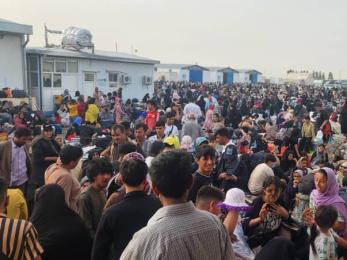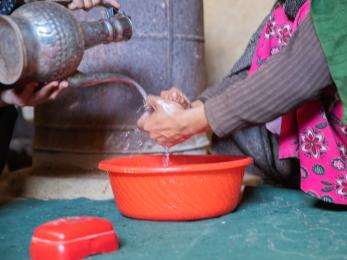Water Innovations Technologies
Lessons on Water Savings and Conservation in Jordan

Jordan is one of the most water-scarce countries in the world. With its population rapidly growing, the demand for water has increased and is straining the country’s already limited resources. The five-year (2017-2022) USAID Water Innovation Technologies (WIT) Programme used a market-based approach in Jordan to improve water use efficiency and water conservation in the agricultural sector, in communities, and in households
Our Studies
A Household Loan Programme for the Adoption of Water Saving Technologies in Jordan
This report summarises the key findings from the analysis of the WIT Household Loan Programme (HLP) performance and economics and the main results from the economic evaluation.
The Household Loan Programme (HLP) was an integral part of the Water Innovation Technologies (WIT) programme, accounting for $6.6 million of the $27.3 million outlay (24%) on the programme by Mercy Corps (including direct and indirect costs through the end of September 2021). Prior economic analysis of the cost-effectiveness of WIT activities reveals that the water saved through the programme was achieved at an average unit cost of $0.36 per cubic meter. This is an attractive cost compared with other water supply options in Jordan. WIT’s average performance, however, came with considerable variation, the cost of the HLP being on the higher end of this distribution.
To better understand the HLP, its performance and economics, a full investigation of the loan portfolio was carried out to understand the size, type, and amounts of loans, their repayment status (as of March 2022), and the extent of subsequent lending. A loan simulation model based on the programme’s performance to date was then developed to better understand the long run cost-effectiveness, private rate of return and net present value of the HLP. The analysis concludes that properly accounting for indirect costs of WIT and the revolving (not one-off) nature of the loans improves the economic outcomes generated by the HLP. This makes such a revolving fund for residential water conservation a promising tool for Jordan as it addresses chronic water scarcity and increasing water insecurity.
Harnessing Market Systems for Water Conservation in Jordan
Download the executive summary ▸
Download the full report ▸
This five-year (2017-2022) USAID-funded programme is one of the first large-scale applications of the Market Systems Development (MSD) approach to water conservation and the first one of its kind in Jordan. WIT leveraged the power of market incentives and businesses to reduce the consumption of irrigation water. WIT household and agricultural components combined led to total savings of 28 MCM of water, exceeding the original target of 18.5 MCM by 51%, and are equivalent to 11,000 Olympic pools. On the agriculture component alone, the efforts of WIT’s partners and farmers led to the optimisation of over two thousand hectares of farmland and savings of 24 MCM of water for irrigation, representing almost 10% of all the underground water consumed by the agriculture sector in 2017.
The WIT programme worked on two market systems: agricultural irrigation and domestic consumption. This report, Harnessing Market Systems for Water Conservation in Jordan, focuses exclusively on agriculture because it is the biggest user of water globally. We identified four main areas that significantly contributed to structural improvements in the Water Savings Technology (WST) market and water saving:
- Access to information on benefits and availability of WSTs.
- Building capacity for engagement between market actors.
- Access to finance to enable investments in WSTs.
- Creation of spaces for interaction and learning.
In addition to the water saving impacts, the report also discusses WIT’s evolution and the main areas of intervention from an MSD perspective.
Impact on Groundwater in Jordan to Water Savings Technologies
This study on the Impact on Groundwater in Jordan to Water Savings Technologies provided the WIT Team with a baseline on crop types, water use, over-irrigation, and groundwater aquifer availability and salinity in Azraq and Mafraq areas to inform programme interventions and and an understanding of simulated changes in groundwater levels in response to adoption of irrigation water saving technologies in Azraq and Mafraq during the period 2019-2023. Under an assumption there will be no changes in crop types, the study applied a series of “what if” questions to understand the response of groundwater levels under different scenarios (i.e., Irrigation amounts increased by 20 percent). This scenario analysis supported the International Center for Biosaline Agriculture (ICBA) and the WIT teams to determine the target locations with the highest potential for the WIT interventions to impact water savings while sustaining crop productivity.
Economics of Water Savings Under the Jordan Water Innovation Technologies Project
This research on the Economics of Water Savings Under the Jordan Water Innovation Technologies Project leveraged relevant data, information, and studies already completed as part of WIT to 1) estimate the cost-effectiveness of investment in each WIT activity in terms of promoting the adoption of water saving approaches (WSAs) by households, farmers and communities; and 2) assess the motivations for and costs/benefits of WSAs adopted as part of WIT to both private (i.e., suppliers, farmers, and households) and public actors (i.e., USAID and Mercy Corps). The findings suggest that a) funding water saving projects in Jordan, particularly with a Market Systems Development (MSD) component, may be less expensive than other alternatives; and b) WSA adoption often has a positive return on investment for the adopter even if they bear the full cost of adoption, and therefore, should be strongly encouraged as part of government policy and donor funding.
Understanding the Change in Irrigation Behavior
One of the proven water-savings technologies that the WIT project introduced is improved drip irrigation with pressure compensating emitters on farms. This technology ensures a more uniform application of water across a field irrespective of pressure variations due to elevation or friction in long lengths of pipe. This study, Understanding the Change in Irrigation Behavior, was carried out to understand the changes in farmer behavior after installing analog water meters on farms where investments have been made in water savings technology. The major finding was that water metering within a farm, e.g., on individual zones, and more importantly, information that farmers efficiently synthesise, is also a water-savings technology in its own right alongside drip irrigation technologies. Water accounting, therefore, is a suitable tool to influence farmers' water use behavior and achieve a sustainable positive change in their attitude towards water.


